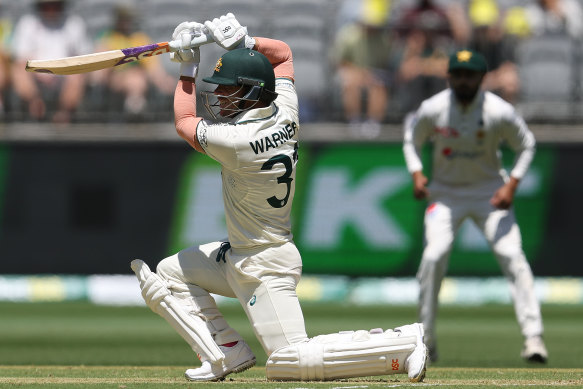That’s why they didn’t drop him: Warner repays selectors
Save articles for later
Add articles to your saved list and come back to them any time.
Perth: That’s why they didn’t drop him.
If the sort of performance David Warner unfurled in Perth has become less frequent than it once was, his capacity to make a rapid, agenda-setting century for Australia at the top of the order in Test matches at home is still the best in the country.
And against Pakistan, the team Warner has saved many of his most outrageous displays for, the 36-year-old crushed 164 from 211 balls. It was the sort of innings that only Virender Sehwag or Viv Richards have conjured as often as Warner over 146 years of Test match history.
David Warner with a sumptuous cover drive.Credit: Getty Images
Some of Australia’s coaches and selectors dined with Warner in Perth’s Chinatown district on match eve. This was in keeping with the collaborative and thoughtful environment fostered by Andrew McDonald and George Bailey. But theirs was not a selection based on sentiment.
As Pat Cummins made patently clear on match eve, Australia need to win these home Test by big margins in order to catchup ground lost on the World Test Championship table due to over-rate penalties during the Ashes. Warner was in a hurry to make up those lost points.
With due respect to Cameron Bancroft, Marcus Harris and Matt Renshaw, Warner’s hundred at Perth Stadium provided evidence that even past his best, the left-hander is still in a different class to his aspiring usurpers. Much as the selectors have always felt.
Albeit on a pudding of a pitch in Canberra, none of Bancroft, Harris or Renshaw were able to set the agenda against a Pakistani attack that was weaker than this one. Renshaw did best, but his innings of 136 was in the mode of a classical top order player, showing plenty of patience but no great amount of punch.
Warner, by contrast, has only two genuine competitors in the history of Test cricket for rapid scoring over such a long career: Sehwag and Richards. Fittingly, he passed both of them on the all-time Test match scoring list during this innings.
In an era of far more sedate Test match scoring, Richards as rightly known as the “Master Blaster”, because his strike rate of almost 70 gave the West Indies a consistent advantage in terms of runs made rapidly.
Richards, of course, was often coming in behind the formidable opening combination of Desmond Haynes and Gordon Greenidge, meaning he could often feast on tiring bowlers and a ball that had lost its shine.
Then there is Sehwag, the firebrand opener who revolutionised top-order batting by playing utterly without fear or filter while slamming his runs at a strike rate of better than 82 runs per 100 balls.
Among other players with more than 8000 Test runs, even the likes of the intimidatory Matthew Hayden scored his runs at a strike rate of around 60. Warner passed Hayden’s aggregate on this day too, and by stumps had also surged past the tally of Michael Clarke to enter Australia’s top five.
Run machine: David Warner celebrates.Credit: Getty
Like Warner, Sehwag occasionally struggled against the moving ball overseas, especially in England and South Africa. And in India he had the advantage of lower bounce and the fact the ball did not seam so much on local pitches.
But he was also skilful enough to do very well in Australia, averaging better than 46 and striking at around 75: his coruscating hundred on Boxing Day in 2003 remains one of the most remarkable innings ever seen at the MCG.
Intrinsically, Sehwag knew his game was one of risk versus reward, putting new-ball bowlers under pressure so they could not settle. As he once told Greg Chappell: “Sehwag is frightened of fast bowlers, but fast bowlers are frightened of Sehwag!”
Warner, too, has been a master of making his own batting life easier by scrambling bowlers with the pressure he creates through fast scoring and aggressive running between the wickets.
This was summed up aptly on day one in Perth, as Warner capitalised on the fact that Pakistan’s spearhead Shaheen Afridi did not get things exactly right from the start.
Searching for away swing but dropping too short, Shaheen found Warner’s pads for a single first ball of the match. When he drifted wide, Warner swung his bat like a meat axe, not always finding the middle but clearing the slips cordon if he didn’t.
That sort of aggression allowed Usman Khawaja to bat serenely in Warner’s slipstream – wearing his black armband in support of Palestine – until the pair had put on 126 in fewer than 30 overs. When Khawaja finally fell, it was because Shaheen had found the right full length for movement – something Warner’s attack made it harder to find.
“You’ve really got to ride that length they bowl and if they miss that spot you’ve got to put it away,” Warner said. “Sometimes oppositions come to Australia and they pitch one or two up and you drive it back down the ground, [and] then they get off that length.
“Whereas our bowlers just constantly try to hit that length and consistently do, and want you to hit straight past them. I don’t think I scored a run down the ground today, and that’s when you know you’ve got them off their length. That’s what I try to do from ball one.”
It is no coincidence that India’s two Test series wins in Australia coincided with Warner’s Newlands ban (2018-19) and then a serious groin strain (2020-21) that ruled him out of the first two Tests and ensured he was far from fit for the last two. Since Warner’s debut, they are two of just four series losses for Australia at home.
With only two overseas Tests – in New Zealand – between now and next summer against India, the question for the selectors may not be the public one: why has Warner been allowed to hang around so long? Instead, it may be more like this: how do we win Test matches in Australia without him?
News, results and expert analysis from the weekend of sport sent every Monday. Sign up for our Sport newsletter.
Most Viewed in Sport
From our partners
Source: Read Full Article

